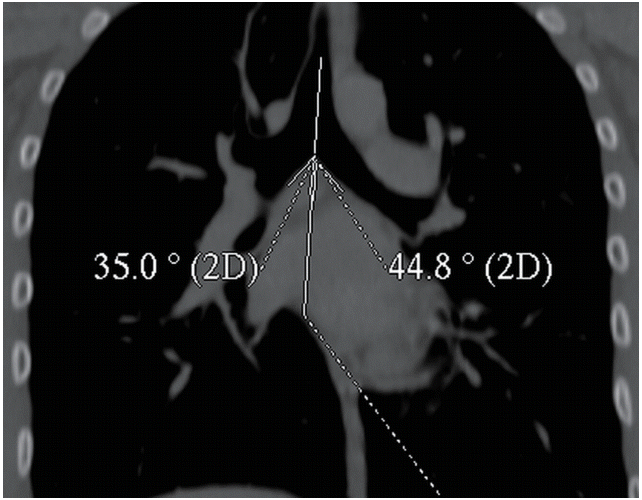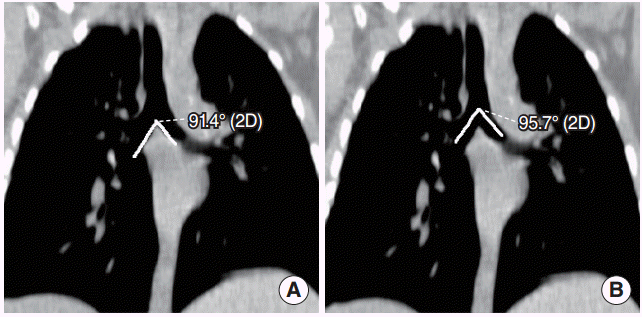1. Haskin PH, Goodman LR. Normal tracheal bifurcation angle: a reassessment. AJR Am J Roentgenol. 1982; Nov. 139(5):879–82.

2. Karabulut N. CT assessment of tracheal carinal angle and its determinants. Br J Radiol. 2005; Sep. 78(933):787–90.

3. Chunder R, Nandi S, Guha R, Satyanarayana N. A morphometric study of human trachea and principal bronchi in different age groups in both sexes and its clinical implications. Nepal Med Coll J. 2010; Dec. 12(4):207–14.
4. Chunder R, Guha R. A morphometric study of human subcarinal angle in different age groups in both sexes and its clinical implications. Indian J Basic Appl Med Res. 2015; Mar. 4(2):424–30.
5. Mi W, Zhang C, Wang H, Cao J, Li C, Yang L, et al. Measurement and analysis of the tracheobronchial tree in Chinese population using computed tomography. PLoS One. 2015; Apr. 10(4):e0123177.

6. Kamel KS, Lau G, Stringer MD. In vivo and in vitro morphometry of the human trachea. Clin Anat. 2009; Jul. 22(5):571–9.

7. Tahir N, Ramsden WH, Stringer MD. Tracheobronchial anatomy and the distribution of inhaled foreign bodies in children. Eur J Pediatr. 2009; Mar. 168(3):289–95.

8. Murray JG, Brown AL, Anagnostou EA, Senior R. Widening of the tracheal bifurcation on chest radiographs: value as a sign of left atrial enlargement. AJR Am J Roentgenol. 1995; May. 164(5):1089–92.

9. Daroszewski M, Szpinda M, Flisinski P, Szpinda A, Wozniak A, Kosinski A, et al. Tracheo-bronchial angles in the human fetus: an anatomical, digital, and statistical study. Med Sci Monit Basic Res. 2013; Jul. 19:194–200.
10. Fong EW. Tracheo-bronchial angles in the human fetus: an anatomical, digital, and statistical study. In : Yamamoto L, editor. Case based pediatrics for medical students and residents. 2nd ed. Honolulu, HI: Department of Pediatrics, University of Hawaii John A. Burns School of Medicin;2002. p. 311–4.
11. Itasca IL. National Safety Council: injury facts, 2001 ed. Itasca, IL: National Safety Council;2001.
12. Cohen SR, Herbert WI, Lewis GB Jr, Geller KA. Foreign bodies in the airway: five-year retrospective study with special reference to management. Ann Otol Rhinol Laryngol. 1980; Sep-Oct. 89(5 Pt 1):437–42.
13. Daniilidis J, Symeonidis B, Triaridis K, Kouloulas A. Foreign body in the airways: a review of 90 cases. Arch Otolaryngol. 1977; Oct. 103(10):570–3.

14. Van Looij MA, Rood PP, Hoeve LJ, Borgstein JA. Aspirated foreign bodies in children: why are they more commonly found on the left? Clin Otolaryngol Allied Sci. 2003; Aug. 28(4):364–7.

15. Baharloo F, Veyckemans F, Francis C, Biettlot MP, Rodenstein DO. Tracheobronchial foreign bodies: presentation and management in children and adults. Chest. 1999; May. 115(5):1357–62.
16. Kubota Y, Toyoda Y, Nagata N, Kubota H, Sawada S, Murakawa M, et al. Tracheo-bronchial angles in infants and children. Anesthesiology. 1986; Mar. 64(3):374–6.

17. Adriani J, Griggs TS. An improved endotracheal tube for pediatric use. Anesthesiology. 1954; Sep. 15(5):466–70.
18. Landis JR, Koch GG. The measurement of observer agreement for categorical data. Biometrics. 1977; Mar. 33(1):159–74.







 PDF
PDF Citation
Citation Print
Print


 XML Download
XML Download